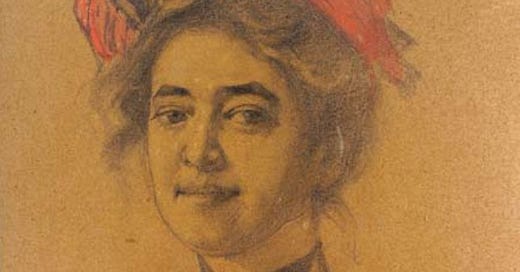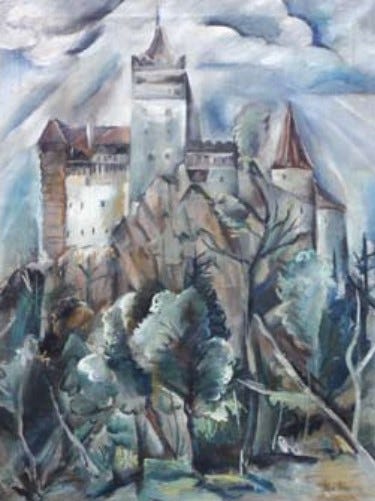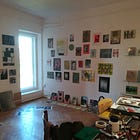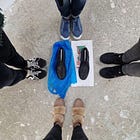“She travelled a lot, she rushed to achieve everything her vibrant temperament dictated. Her life was led with a constant inner burning, between successes and disappointments, travelling or in quiet rest in her studio in Bran…”
Coriolan Munteanu, “Elena Popea”, Luceafărul, 1941.
She gazes up at me from the page with a cryptic smile. Soft lips, dark hooded eyes set beneath thick eyebrows, a round face, a towering hat set on a pile of wispy hair: Elena Popea’s (1879-1941) self-portrait projects an image of a content and self-assured woman. It is a charcoal and tempera sketch, kept in the reserves of the art museum of Cluj-Napoca, Romania. The image often finds its way onto the pages of articles and catalogues dedicated to her, and I have happened upon it on several occasions as I slowly follow in her wandering footsteps. Who was she, as an artist and as a person?
Born in 1879 into a family of Transylvanian intellectuals in Brașov, she went on to study art at the Damenakademie in Munich and then in Paris. She led a successful career as a painter, travelling constantly and exhibiting regularly in Europe. The newspaper cuttings and articles about her paint a picture of an engaging and intrepid woman, constantly seeking out new places to quench her artistic curiosity. Her biographer Maria Dumitrescu writes: “The painter loved travelling, seeing in the confrontations with other cultural environments an opportunity to discover the true dimensions of her own spirituality as well as those of the art and tradition she represented.”
I first encountered her work a few years ago while travelling through Romania. I was struck by her scenes of village life in Brittany, a Dutch landscape, a view of Toledo… hanging beside paintings of her beloved home region of Transylvania: a sunny street in Sighișoara, local peasants and marketplaces, the Bucegi mountains, and the interior and the exterior of the Bran castle. In between her travels across Europe, she would return there often, seeking out the peace and quiet of nature, far from the bustle of urban life and the artistic circles she was involved in. Drawn to the countryside of her childhood, she painted the Bran castle repeatedly. Several of these paintings are now kept in the Brașov art museum.
Bran Castle, oil on cardboard, 32x24,3cm, Brașov Art Museum, Romania.
In Bran Castle, she offers a rather dramatic depiction of the medieval castle. It towers at the top of a rocky hill, looming over the thick vegetation in the foreground, and bathed in celestial light from above. Indeed, the clouds themselves seem to part right above the central turret, sunrays streaming down in diagonals to the right and the left. One’s eye is drawn to the lofty heights of the imposing architectural feature. Popea demonstrates her skill in composition, and whilst the influence of modernist painting and especially that of cubist painter André Lhote (1885-1962) - with whom she trained - is apparent in the sharp angles, simplified geometric forms, and quick but decisive brushstrokes, she remains a distinctive and original artist, offering to the viewer a personal and subjective interpretation of the landscape. Note also her skill as a colorist, blue and green hues creating an eerie and unsettling atmosphere. Her contemporaries also remarked on her talent, such as art critic Petru Comarnescu who commends her “vigorous drawing” and her skill in tackling the “ever-changing problems of colour”.
Her interpretation of the scene is far removed from my memory of the castle. I visited it one sunny autumn day, and I remember the throngs of tourists and the large school groups milling about the place. The village of Bran lies at the foot of the castle, and its streets are now strewn with souvenir stalls, Dracula-themed knick-knacks, embroidered shirts, and other trinkets spilling onto the pavement.
Bran Castle, oil on cardboard, 80x60cm, Brașov Art Museum, Romania.
In a slightly larger oil painting, also kept in the reserves of the Brașov art museum, Popea depicts Bran in a more naturalistic manner. The castle is set in the background under an overcast sky, its base blending with the surrounding vegetation which occupies over half the space. Several traditional houses, their roofs protruding above the trees, seem to disappear into the landscape, and a path makes its way with difficulty through the thick overgrowth. Earthy and natural tones – browns and greens – dominate. Contrary to the previous painting, the castle here does not overpower the scene. In fact it seems to echo the vegetation both in shape and colour.
But in both cases, the paintings speak to the artist’s strong ties with the place she represents. She had, in the words of Romanian writer Aurel D. Broșteanu, a deep “passion for the harmonies of her native landscape”. Bran and its surroundings were “more than just a subject for painting, it was an opportunity for her to face her origins”, and “that is why Elena Popea's paintings were never harsher nor more nostalgic than these unfinished landscapes - as she liked to call them - of Bran. Never was the dialogue between heaven and earth more dramatic. Never did the whirlwind of stirring passion throb more intensely.”
I did not stay there long enough to develop such a deep passion for the region. I continued my travels a few days later, leaving behind Transylvania and its rolling hills, dark forests, derelict castles, and inhospitable youth hostels. And now, as I gaze at Elena Popea’s self-portrait, as I walk the trail of her travels, piecing together her life and work through letters, newspaper articles and exhibition catalogues, I feel evermore close and distant to her and the country she knew.
I close the book – her self-portrait returns to its state of printed pixels squashed between two pages of text. But I carry with me the memory of her cryptic smile and, as I set off in her footsteps, I hope to see a bit of the world through her eyes. I hope too for you, dear reader, to follow along the way…
Self-portait, charcoal and tempera, 65x42,5cm, Cluj-Napoca Art Museum, Romania.
Maria Dumitrescu, Elena Popea, Editions Meridiane, Bucarest, 1969.
Iulia Mesea, “Restituiri: Elena Popea - Lucrări cu tematică peisagistă (Colecţia Muzeului naţional Brukenthal, a Muzeului de artă Braşov şi în deţinere privată)”, in Brukenthal. Acta Musei, IV.2, Sibiu, 2009, pp.455-472.
Coriolan Munteanu, “Elena Popea”, Luceafărul, an I, nr. 7, October 1941.
Iona Vlasiu, “Elena Popea : construirea carierei artistice », in Cosmin Nasui, Artiste uitate din România : cercetări și studii despre contribuția femeilor la istoria artei românești, PostModernism Museum Publishing House, 2021, p. 262-271.








